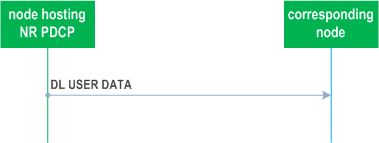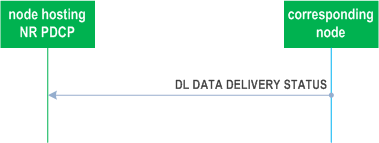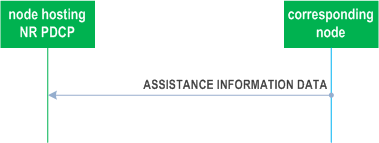Content for TS 38.425 Word version: 18.1.0
5 NR user plane protocol
5.1 General
5.2 NR user plane protocol layer services
5.3 Services expected from the Transport Network Layer
5.4 Elementary procedures
5.4.1 Transfer of Downlink User Data
5.4.2 Downlink Data Delivery Status
5.4.3 Transfer of Assistance Information
...
...
5 NR user plane protocol p. 7
5.1 General p. 7
The NR user plane protocol layer is using services of the transport network layer in order to allow flow control of user data packets transferred from the node hosting PDCP to the corresponding node.
5.2 NR user plane protocol layer services p. 7
The following functions are provided by the NR user plane protocol:
- Provision of NR user plane specific sequence number information for user data transferred from the node hosting NR PDCP to the corresponding node for a specific data radio bearer.
- Information of successful in sequence delivery of NR PDCP PDUs to the UE from the corresponding node for user data associated with a specific data radio bearer.
- Information of NR PDCP PDUs that were not delivered to the UE or not transmitted to the lower layers.
- Information of NR PDCP PDUs transmitted to the lower layers for user data associated with a specific data radio bearer.
- Information of downlink NR PDCP PDUs to be discarded for user data associated with a specific data radio bearer;
- Information of the currently desired buffer size at the corresponding node for transmitting to the UE user data associated with a specific data radio bearer.
- Information of the currently desired data rate in bytes at the corresponding node for transmitting to the UE user data associated with a specific data radio bearer;
- Information of successful in sequence delivery of NR PDCP PDUs to the UE from the corresponding node for retransmission user data associate with a specific data radio bearer;
- Information of NR PDCP PDUs transmitted to the lower layers for retransmission user data associated with a specific data radio bearer.
- Information of the specific events at the corresponding node.
- Information on Radio Link Quality from the corresponding node for user data associated with a specific data radio bearer.
- Information for QoS monitoring from the corresponding node for user data associated with a specific data radio bearer.
5.3 Services expected from the Transport Network Layer p. 8
The NR user plane protocol layer expects the following services from the Transport Network Layer:
- Transfer of user data.
5.4 Elementary procedures p. 9
5.4.1 Transfer of Downlink User Data p. 9
5.4.1.1 Successful operation p. 9
The purpose of the Transfer of Downlink User Data procedure is to provide NR-U specific sequence number information at the transfer of user data carrying a DL NR PDCP PDU from the node hosting the NR PDCP entity to the corresponding node.
An NR user plane protocol instance making use of the Transfer of Downlink User Data procedure is associated to a single radio bearer only.
The node hosting the NR PDCP entity shall assign consecutive NR-U sequence numbers to each transferred NR-U packet. A retransmitted NR PDCP PDU shall be assigned a new NR-U sequence number.
The node hosting the NR PDCP entity indicates to the corresponding node whether this NR-U packet is a retransmission of NR PDCP PDU.
The node hosting the NR PDCP entity can indicate to the corresponding node to either discard all NR PDCP PDUs up to and including a defined DL discard NR PDCP PDU SN or discard one or a number of blocks of downlink NR PDCP PDUs.
If the Assistance Information Report Polling Flag is equal to 1, the corresponding node shall, if supported, send the ASSISTANCE INFORMATION DATA to the node hosting the NR PDCP entity.
The corresponding node shall detect whether an NR-U packet was lost and memorise the respective sequence number after it has declared the respective NR-U packet as being "lost".
The corresponding node shall transfer the remaining NR PDCP PDUs towards the UE and memorise the highest NR PDCP PDU sequence number of the NR PDCP PDU that was successfully delivered (as defined in TS 36.322 and TS 38.322) in sequence towards the UE (in case RLC AM is used) and the highest NR PDCP PDU sequence number of the NR PDCP PDU that was transmitted to the lower layers.
The corresponding node shall send the DL DATA DELIVERY STATUS if the Report Polling Flag is set to 1 or when the NR PDCP PDU with the indicated DL report NR PDCP PDU SN has been successfully delivered, unless a situation of overload at the corresponding node is encountered. The DL DATA DELIVERY STATUS sent as a response to a specific DL report NR PDCP PDU SN shall be sent only when all PDCP PDU SNs up to this DL report NR PDCP PDU have been successfully delivered in-sequence.
If the Request OutOfSeq Report is set to 1, the corresponding node shall, if supported, include the NR PDCP PDU sequence number successfully delivered out of sequence in the DL DATA DELIVERY STATUS to the node hosting the NR PDCP entity.
If the User data existence flag is set to 1, the corresponding node assumes that the node hosting the NR PDCP entity has some user data for the concerned data radio bearer. The corresponding node decides whether and when to use DRX for the UE (i.e. the corresponding node may indicate the UE to use DRX even if the flag is set to 1 and the received DL USER DATA frame contains no user data).

5.4.1.2 Unsuccessful operation p. 10
Void.
5.4.2 Downlink Data Delivery Status p. 10
5.4.2.1 Successful operation p. 10
The purpose of the Downlink Data Delivery Status procedure is to provide feedback from the corresponding node to the node hosting the NR PDCP entity to allow the node hosting the NR PDCP entity to control the downlink user data flow via the corresponding node for the respective data radio bearer. The corresponding node may also transfer uplink user data for the concerned data radio bearer to the node hosting the NR PDCP entity together with a DL DATA DELIVERY STATUS frame within the same GTP-U PDU.
The Downlink Data Delivery Status procedure is also used to provide feedback from the corresponding node to the node hosting the NR PDCP entity to allow the node hosting the NR PDCP entity to control the successful delivery of DL control data to the corresponding node.
When the corresponding node decides to trigger the feedback for Downlink Data Delivery procedure it shall report as specified in clause 5.2:
- in case of RLC AM, the highest NR PDCP PDU sequence number successfully delivered in sequence to the UE among those NR PDCP PDUs received from the node hosting the NR PDCP entity i.e. excludes those retransmission NR PDCP PDUs; For all other cases, if the NR user plane protocol instance is associated with an MRB configured with at least one RLC AM entity and RLC-UM, the highest successfully delivered NR PDCP sequence number indicates the combined feedback of the highest NR PDCP sequence number successfully delivered in sequence to all the involved UEs for which the RLC AM entites have been configured, no retransmissions are performed, and the highest NR PDCP sequence number transmitted to the lower layers for PTM.
- the desired buffer size in bytes for the concerned data radio bearer or for the MRB;
- optionally, the desired data rate in bytes associated with a specific data radio bearer configured for the UE or for the MRB;
- the NR-U packets that were declared as being "lost" by the corresponding node and have not yet been reported to the node hosting the NR PDCP entity within the DL DATA DELIVERY STATUS frame;
- if retransmission NR PDCP PDUs have been delivered, the NR PDCP PDU sequence number associated with the highest NR-U sequence number among the retransmission NR PDCP PDUs successfully delivered to the UE in sequence of NR-U sequence number;
- if retransmission NR PDCP PDUs have been transmitted to the lower layers, the NR PDCP PDU sequence number associated with the highest NR-U sequence number among the retransmission NR PDCP PDUs transmitted to the lower layers in sequence of NR-U sequence number;
- the highest NR PDCP PDU sequence number transmitted to the lower layers among those NR PDCP PDUs received from the node hosting the NR PDCP entity i.e. excludes those retransmission NR PDCP PDUs;
- in case of RLC AM, the NR PDCP PDU sequence number successfully delivered out of sequence to the UE among those NR PDCP PDUs received from the node hosting the NR PDCP entity i.e. excludes those retransmission NR PDCP PDUs.
-
regards the desired buffer size under b) and the data rate under c) above as the amount of data to be sent from the hosting node:
- If the value of the desired buffer size is 0, the hosting node shall stop sending any data per bearer.
-
If the value of the desired buffer size in b) above is greater than 0, the hosting node may send up to this amount of data per bearer:
- first including the data to be retransmitted;
- then the new data, starting from the last "Highest successfully delivered NR PDCP Sequence Number" for RLC AM if received, or starting from the last "Highest transmitted NR PDCP Sequence Number" for RLC UM if received.
- The value of the desired data rate in c) above is the amount of data desired to be received in a specific amount of time. The amount of time is 1 sec.
- The information of the buffer size in b) above and of the data rate in c) above is valid until the next DL DATA DELIVERY STATUS frame is received.
- is allowed to remove the buffered NR PDCP PDUs of a RLC AM bearer, according to the feedback of successfully delivered NR PDCP PDUs;
- decides upon the actions necessary to take for NR PDCP PDUs reported other than transmitted and/or successfully delivered.

5.4.2.2 Unsuccessful operation p. 12
Void.
5.4.3 Transfer of Assistance Information p. 12
5.4.3.1 Successful operation p. 12
The purpose of the Transfer of Assistance Information procedure is to provide assistance information to the node hosting the NR PDCP entity. Such information may be taken into consideration by the node hosting the NR PDCP entity for UP management and optimisation procedures.
An NR user plane protocol instance making use of the Transfer of Assistance Information procedure is associated to a single data radio bearer only.
The Transfer of Assistance Information procedure may be invoked if
- the corresponding node decides to send the Radio Quality Assistance Information and/or the PDCP duplication activation suggestion to the node hosting the NR PDCP entity for the concerned data radio bearer or,
- the corresponding node decides to send the Radio Quality Assistance Information to the node hosting the NR PDCP entity for the concerned RLC entity.
